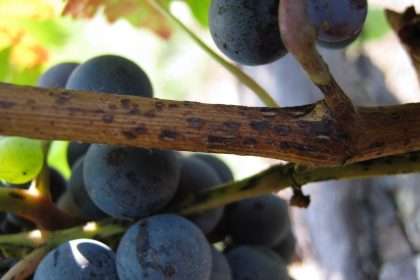I have received several emails and phone calls regards to downy mildew and Botrytis last week. Also, some people are struggling with powdery mildew. Here are general options against these diseases at this time of the season.
Downy mildew: At this point, your berries are out of susceptible period. However, because of the last minutes rain some of us had about two weeks ago, some locations are experiencing downy on clusters. Thing is that the infection took place a while ago, and there are not much options available. For kick-back activity, you can use Ridomil Gold Copper (note: it also have 42-day PHI), or Phosphorous acid materials such as Prophyt or Agri-Fos (0-day PHI). However, please keep in your mind that kick-back activity is for on-going infection, but not for already established colonies (i.e., if you see downy growth, these are established colonies). If there are only minor colonies, you may able to keep them contained in the small area by applying these materials. If you have an outbreak of downy on cluster, you can try Phosphorous acid material mixed with captan.
For protection, most of varieties are within 66 days of harvest, thus, you cannot use any materials contains mancozeb (i.e., Penncozeb, Ridomil Gold MZ). You can use copper materials (0-day PHI, but please keep in your mind that many wine makers do not want you to use copper close to the harvest), Revus (Revus or Revus Top, 14-day PHI), Ziram (21-day PHI), Captan (0-day PHI), Ranman (30-day PHI), Pristine (14-day PHI) etc.
Botrytis: It seems that Botrytis found its way to infect some of early season varieties (namely Chardonnay) this year, even if at bloom application was made. My guess is that it came in soon after the effect of the bloom application was gone (many of us experienced 5 to 10 days of very humid nights in early to mid June, and some of you in the central VA received hail and rains during that time too). Unfortunately, none of Botrytis materials are curative, thus, you are basically aiming to protect healthy berries.
There are number of Botrytis materials; however, please make sure to read the label carefully. Some of them are using the same mode of action, even if chemicals and brand names are different. For example, Switch, Scala, Vangard, Inspire Super contain a chemical with the same mode of action (FRAC code 9). Thus, a rotation among them are not really a rotation. You can find about a list of FRAC code on my spray guide or VT’s PMG (you can download them from the link on the right).
Our regular recommendation is the application at bunch closure (especially for tight cluster varieties, since it will be the last opportunity to deliver chemicals into clusters), and veraison (a study showed high number of spores during verison, and also, sugar level increases –> Botytis likes high sugar content).
Powdery: As with downy mildew, your berries are probably out from the susceptible period by now. The infection on clusters you see today probably happened a week or two ago. Thus, for next year, please make sure to have a good protection program (or make sure your equipment is working properly).
If you have outbreak of powdery on clusters that need to be controlled, you may want to try Potassium bicarbonate products such as Kaligreen or Armicarb. You need a through coverage to achieve a good efficacy. The other option is Oxidate which also requires through coverage and 3-time back-to-back application. Based on previous reports, it seems that Kaligreen or Armicarb provide a little better efficacy than Oxidate. Please avoid using high or moderate risk materials (i.e., strobies, DMIs, etc) against on-going powdery mildew outbreak. You do not want to have resistance isolate in your vineyards.
If you successfully protected your berries up to this point, you can probably relax a bit on both downy and powdery mildew. Just watch the weather and also keep eyes on incoming downy and powdery on young foliages, and make decision based on them.


